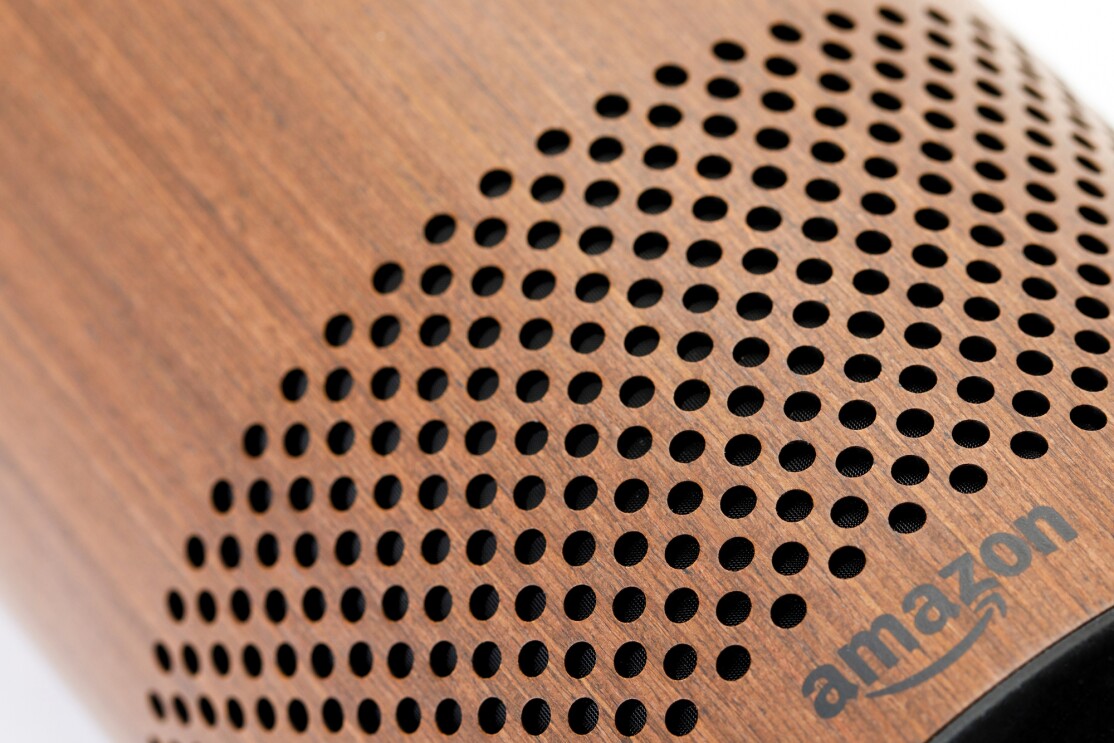Finding the perfect song can be hard. You might know the lyrics of a song you like, but you don’t know its name. You might want to play a song from the newest Ariana Grande album – but only the one you heard on the radio that morning. Or you might want to listen to happy funk music from the 1970s, but don’t know the best tunes from that era.
As it turns out, these are precisely the kinds of problems that the team at Amazon Music has been solving for customers since launching Amazon Music Unlimited nearly two years ago.
 Amazon Music director of product management Kintan BrahmbhattPhoto by JORDAN STEAD / Amazon
Amazon Music director of product management Kintan BrahmbhattPhoto by JORDAN STEAD / Amazon“Over the last several years, the growth in streaming music has primarily been driven by mobile,” says Kintan Brahmbhatt, Director of Product and Technical Program Management for Amazon Music.
“But mobile required people to be very specific about their intent while searching for music in non-intuitive ways – such as typing out the name of an artist or specifying an exact search term. Instead, we’ve reduced the friction to offer a natural experience for customers. We’ve made Amazon Music on Alexa easy, intuitive, and in-tune with human behavior - you can be as specific or as vague in your request and we’ll find the music you love."
Prime Music, Amazon’s first music streaming service, became available at no additional cost for Prime members in June 2014. Shortly after, as the Echo launched, Amazon Music began investing in unique voice-specific use cases for discovering, playing, and managing music. And as customers started increasingly asking Alexa for music, the launch of Amazon Music Unlimited in 2016 enabled a broader catalog with fundamentally new ways of discovering and playing music that were not available or possible earlier.
And ever since, the Amazon Music team has been creating new features for a voice-first world. These include the ability to create playlists by voice, play personalized music for occasions like a dinner party, or listen to music hands-free while in the car or exercising via the Amazon Music mobile app. People can even subscribe to Amazon Music simply by asking Alexa to sign up for the service. This voice-forward approach has struck a chord with consumers – in just a few months after launching Amazon Music Unlimited, Alexa surpassed mobile as the leading way consumers listen to songs on Amazon Music.
How it works
But just how does Amazon Music know what to do when you ask her to “play happy music” on Alexa? To unpack the process from when you make request to when the song is played, let’s start at the very beginning.
First, Alexa has to go through a catalog of tens of millions of tracks to identify the songs that we might think of as “happy”. But just what is a happy song? Turns out that every song has features that can help Amazon Music determine its mood. These include features like sonic attributes, including tempo (the number of beats per minute) and the interval between a note and a reference pitch. To give just one example, in many Western songs, the major fifth (or E note) conveys a feeling of happiness, while the minor seventh “blue” note invokes a touch of melancholy.
01 / 04
But making judgments based on feature vectors isn’t enough. When it comes to music, the whole is greater than the sum of its parts. A cow may moo in the major fifth, but that sound would seldom cause our soul to leap with joy. Like language, there is something about music that is uniquely human. Teaching Alexa how to recognize moods requires an expert human touch.
“It’s not just technology,” Brahmbhatt says. “We’ve also invested in building out a team of global, music experts across a variety of languages. They work along with Amazon Music to give our customers a truly differentiated and relevant musical experience.”
In this case, Amazon’s musical curators assess and validate the small dataset of songs that Alexa has marked as “happy”. Their feedback is used to fine-tune the machine learning algorithm until Alexa has gotten it just right. The algorithm is then set loose on the entire catalog of Amazon Music’s tens of millions of songs, after which the algorithm classifies songs as “happy”, or with a specific mood.
And there’s more. You say happy. I might say cheerful. Amazon Music’s team of scientists, engineers, and linguists have to think of a variety of synonyms when applying moods to songs. They also have to account for regional differences. India alone has more than 22 languages and over 720 dialects. Musical structures and meanings vary across cultures and subcultures. Amazon Music has to account for the differences between people asking for happy songs on Amazon Music in Punjab and Tamil Nadu – the musical stylings of Channi Singh would not go as far in Chennai in making people feel happy as it would in Ludhiana or Amritsar.
Music touches the lives of every human being. What we listen to is a core part of our identity and serves as a drumbeat for our lives.
Kintan Brahmbhatt, Amazon Music director of product management
Finally, Alexa also has to account for your personal tastes. For example, “happy” for you might mean “Here Comes the Sun.” For your roommate, it could mean the edgier “Anarchy in the U.K.” – a song that might make you feel sad (or even angry).
“We obsess constantly over many scenarios and factors to help our customers easily find the music that’s just right for them,” says Brahmbhatt. “And as it so often does, this simplicity in customer experience involves a lot of complexity behind the scenes.”
The word ‘obsess’ is not a hyperbole. The Amazon Music team spends a majority of the day going over the different ways customers might ask for music. This often helps them come up with startling insights.
Take what happens when a highly anticipated album is released. To give just one example, you might ask Alexa to “play the latest single by Ariana Grande”. In this case, the latest album “Sweetener” has fifteen songs and the artist has already released a few singles. However, when you ask Alexa to play a song from the album you have a particular track in mind. You’re thinking of “No Tears Left to Cry,” her recent release that’s currently receiving radio play across the country.
To accomplish this, the Amazon Music team added a field “single promotion date” to all the songs in the database. This information helps Amazon Music know when a track was promoted, and play the song you heard during your morning commute.
A companion for your every activity
Unlike reading a book or watching a movie, music is often a secondary activity. We often listen to songs while in the midst of doing something else – going for a run, cooking dinner, or checking our email.
Consider a fairly common scenario. You’re cooking up some tacos for dinner. You hear a song you like. Normally, you’d have to pause what you’re doing. You’d have to touch your phone with your salsa-tinged hands, perform some gymnastics with your fingers, look up the name of the song, and start a new radio station based on that particular track.
 Just say "Alexa, play more like this"Photo by JORDAN STEAD / Amazon
Just say "Alexa, play more like this"Photo by JORDAN STEAD / AmazonWith Amazon Music, you can just say “Alexa, play more like this” while she’s playing your new favorite track. Alexa uses machine learning to come up with a list of songs that are similar to the one that caught your ear. Not surprisingly, given its ease and intuitiveness, playing a similar song, or “more like this,” is one of the more popular things people ask of their Echo.
Another feature that allows people to create playlists simply by chatting with Alexa has proved immensely popular. Within one month of the feature’s launch in beta, Amazon Music listeners had already added hundreds of thousands of songs to playlists while creating tens of thousands of new ones.
Alexa also understands your listening history. Now imagine that it’s your spouse asking Alexa to “play music”. Alexa can identify the voice signature –an electronic representation of your voice—to know that it’s your spouse making the request, and play songs in keeping with his taste. Amazon Music’s machine learning algorithms use factors like genre affinity, artist affinity, and songs that you’ve liked in the past to fine-tune the selection and determine the right song to play at the right time for everyone at home.
What can we expect going forward? Brahmbhatt says that the Amazon Music team will continue working backwards from how customers engage with music in their homes, in their cars, and out in the world, as they help Alexa help you find that perfect song.
“Music touches the lives of every human being,” says Brahmbhatt. “What we listen to is a core part of our identity and serves as a drumbeat for our lives. Be it at home, or in the car, we will continue to help people easily find music that most resonates with them at every moment in time.”
So what can you ask Alexa on Amazon Music?
Asking for music with your voice removes the need to manually search for a specific song or playlist, eliminating access barriers to make streaming more accessible. Amazon Music listeners can ask Alexa for music based on genre, era/decade, mood, tempo, activity, or lyrics, as well as all of the features below that have been released since last August:
Create/Add to User Playlists:
You can ask Alexa to create a new playlist, or add a song from your play queue to an existing personal playlist:
You can ask Alexa to create a new playlist, or add a song from your play queue to an existing personal playlist:
- “Alexa, add this song to my playlist”
- “Alexa, add this to my ‘cooking’ playlist”
- “Alexa, create a new playlist from this song”
Local Popularity:
Find what music is popular in cities and countries around the world just by asking Alexa to play the most popular music in a certain location, creating a new way to discover new tracks and artists you might not have otherwise been aware of:
Find what music is popular in cities and countries around the world just by asking Alexa to play the most popular music in a certain location, creating a new way to discover new tracks and artists you might not have otherwise been aware of:
- “Alexa, play popular songs in Amsterdam”
- “Alexa, play what’s hot in Nashville”
- “Alexa, play music in Mumbai”
- “Alexa, play popular songs in New York”
Music Alarms:
Amazon Music subscribers can ask Alexa to set an alarm just by saying a few words from their favorite song, or a top genre combined with an activity:
Amazon Music subscribers can ask Alexa to set an alarm just by saying a few words from their favorite song, or a top genre combined with an activity:
- “Alexa, wake me up to pop music for running at 5 am”
- "Alexa, set an alarm at 6am to ‘you probably think that you are better now”
- “Alexa, wake me up with relaxing music at 7 am”
 Volume controls for an Amazon EchoPhoto by JORDAN STEAD / Amazon
Volume controls for an Amazon EchoPhoto by JORDAN STEAD / AmazonAmazon Music Activities:
Ask for music for activities such as partying, working out and more, some of which are combinable with our top five genres; pop, country, classical, rock and jazz:
Ask for music for activities such as partying, working out and more, some of which are combinable with our top five genres; pop, country, classical, rock and jazz:
- “Alexa, play classic rock music for a dinner party”
- “Alexa, play pop music for cleaning”
- “Alexa, play country music for running”
- “Alexa, play music for studying”
Recently Played/Haven’t Heard in a While:
With these features, listeners can easily ask for music they’ve listened to previously by artist, genre, or time, eliminating the need to remember specific track titles or scroll through their play history on a visual interface, such as:
With these features, listeners can easily ask for music they’ve listened to previously by artist, genre, or time, eliminating the need to remember specific track titles or scroll through their play history on a visual interface, such as:
- “Alexa, play me the Cardi B song I heard last month”
- “Alexa, play me hip hop music I was listening to three weeks ago”
- Or even try, “Alexa, play music that I was listening to earlier today”
Trending news and stories













